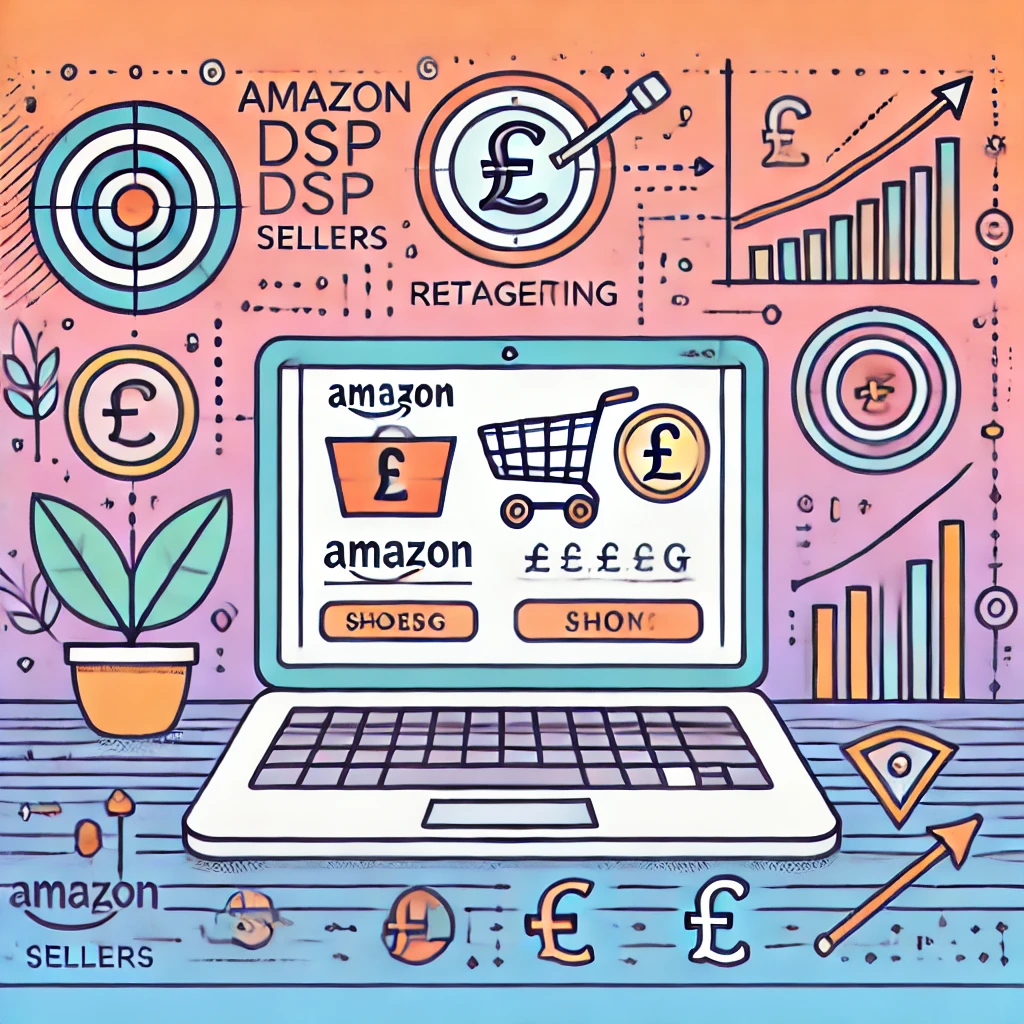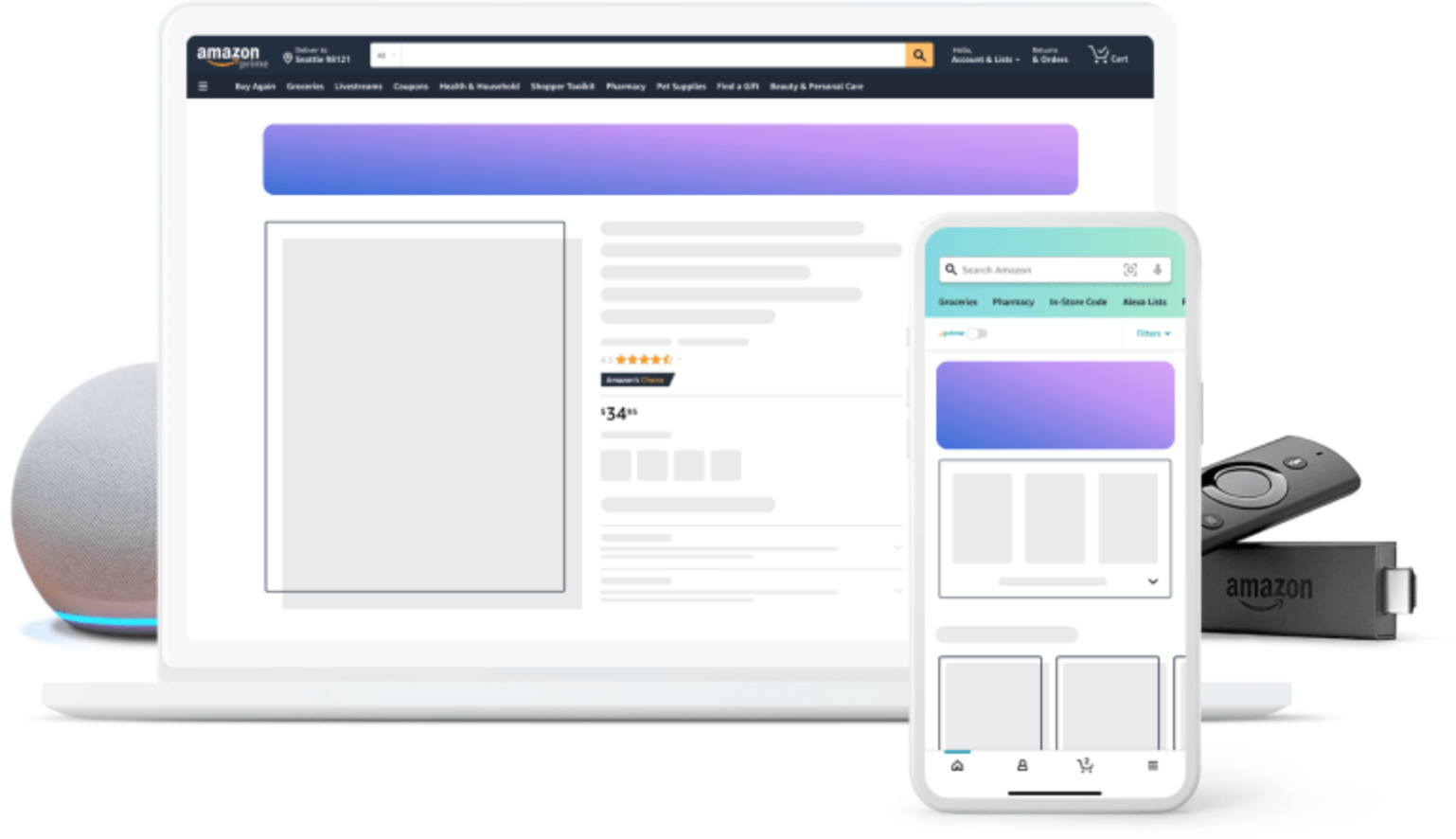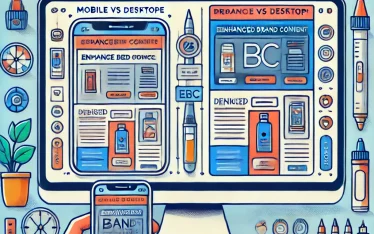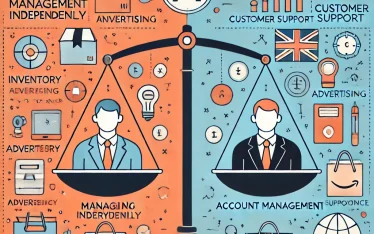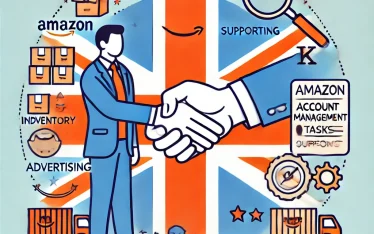TL;DR
- Amazon DSP retargets shoppers who viewed, added to the cart, or searched for similar products
- It works beyond Amazon, showing ads on IMDb, Fire TV, Twitch, and third-party websites
- DSP requires a higher budget (£5,000+ for self-service, £20,000+ for Amazon-managed)
- Small sellers can use DSP through agencies with lower entry points and strategic targeting
- Best strategies include cart abandonment, repeat purchases, cross-selling, and competitor targeting
- Managing DSP yourself is complex—most sellers see better results by hiring an expert Amazon agency
Ever feel like shoppers browse your Amazon listings but never hit “Add to Basket”? You’re not alone. Most online shoppers don’t buy on their first visit—but that doesn’t mean they’re lost forever.
Amazon DSP lets you retarget high-intent shoppers, re-engage past customers, and even reach new audiences beyond Amazon. Whether someone viewed your product but didn’t buy it, added it to their cart and abandoned it, or purchased once but never returned—DSP helps you bring them back and close the sale.
In this guide, we’ll break down how UK sellers can use Amazon DSP to retarget potential buyers, increase conversions, and maximize ad ROI.
Quick guide:
- What is Amazon DSP and how does it work?
- How is Amazon DSP different from Sponsored Ads?
- Who can you retarget with Amazon DSP?
- Where do Amazon DSP ads appear?
- What budget do UK sellers need for Amazon DSP?
- Can small and medium-sized sellers use Amazon DSP?
- What are the best strategies for Amazon DSP retargeting?
- Should you manage Amazon DSP yourself or hire an agency?
What is Amazon DSP and how does it work?
Amazon DSP (Demand-Side Platform) is Amazon’s advanced programmatic advertising tool that allows sellers to run display and video ads both on and off Amazon. Unlike Sponsored Ads, which rely on keyword targeting, DSP helps you reach shoppers based on their behavior, interests, and shopping history—even if they never searched for your product directly.
How does it work?
Amazon DSP uses Amazon’s first-party shopper data to help you retarget potential buyers, acquire new customers, and boost brand awareness. Here’s how:
- Retargeting shoppers – DSP can re-engage people who viewed your product but didn’t buy, reminding them to complete their purchase.
- Lookalike audience targeting – It finds shoppers who behave like your past customers and introduces them to your brand.
- Cross-platform reach – Unlike Sponsored Ads, DSP ads appear beyond Amazon, including popular websites, apps, Fire TV, Twitch, and more.
- Automated and data-driven – The platform uses AI and machine learning to optimize ads in real time, ensuring you get the best ROI.
How is Amazon DSP different from Sponsored Ads?
Amazon DSP and Sponsored Ads both help sellers advertise on Amazon, but they work in completely different ways. If Sponsored Ads are like hunting with a bow and arrow, where you target specific keywords, Amazon DSP is like fishing with a net, where you catch shoppers based on their behavior, interests, and browsing history.
Key differences between Amazon DSP and Sponsored Ads
Targeting method
- Sponsored Ads: Uses keyword-based targeting (like “best wireless earbuds”)
- Amazon DSP: Uses audience-based targeting (retargeting past visitors, lookalike audiences, and interest-based shoppers)
Where ads appear
- Sponsored Ads: Appear only on Amazon (search results, product pages, etc.)
- Amazon DSP: Appears on and off Amazon (Amazon-owned sites like IMDb, Fire TV, Twitch, and external websites/apps)
Ad format
- Sponsored Ads: Mainly product-based ads (Sponsored Products, Sponsored Brands, Sponsored Displays)
- Amazon DSP: Supports rich media formats (video ads, dynamic e-commerce ads, banner ads)
Budget requirements
- Sponsored Ads: Suitable for all sellers (no minimum budget)
- Amazon DSP: Typically requires a higher budget (£5,000+ recommended for managed services)
Campaign goal
- Sponsored Ads: Ideal for driving immediate sales
- Amazon DSP: Works best for brand awareness, retargeting, and long-term customer acquisition
Who can you retarget with Amazon DSP?
- Shoppers who viewed your product but didn’t buy: These are people who clicked on your product page but didn’t add it to their cart or check out. Maybe they got distracted, weren’t ready to buy, or wanted to compare prices. DSP lets you serve them reminder ads across Amazon and external sites to pull them back in.
- Customers who added to cart but abandoned checkout: They were one step away from purchasing but left without completing the order. Retargeting these users with “Almost gone!” or “Limited-time offer” messages can push them to buy.
- Past buyers who haven’t repurchased: If you sell consumables (supplements, skincare, coffee, etc.), DSP can remind customers when it’s time to restock. You can also upsell them on related products based on their past purchases.
- Competitor audiences interested in similar products: DSP allows you to target shoppers who viewed your competitors’ products but didn’t buy. You can show them ads that highlight why your product is a better choice—whether it’s better quality, price, or features.
- Shoppers who searched for related products: Even if they haven’t seen your listing, DSP can retarget users who searched for similar items. This expands your reach to potential buyers you might have missed through keyword-based ads.
Where do Amazon DSP ads appear?
Unlike Sponsored Ads, which only show up on Amazon, Amazon DSP ads appear across multiple platforms. With DSP, your ads follow potential buyers wherever they go, keeping your products top of mind even when they’re browsing other websites or using different apps.
Here’s where Amazon DSP ads can appear:
On Amazon (desktop & mobile)
- Amazon homepage – Prime real estate for brand awareness ads.
- Product detail pages – Retarget shoppers who visited similar products.
- Search results pages – Keep your brand visible even when shoppers browse competitors.
On Amazon-owned platforms
- IMDb – Great for video ads targeting entertainment-focused audiences.
- Twitch – Ideal for reaching gamers and younger audiences.
- Fire TV – Perfect for video-based retargeting, especially for high-ticket products.
On third-party websites & apps
- Amazon DSP extends beyond Amazon, placing your ads on thousands of high-traffic websites and mobile apps.
- Your ads could appear on news sites, blogs, entertainment platforms, and social apps that align with your audience.
- These placements are powered by Amazon’s vast shopper data, so your ads are still targeted to high-intent buyers.
In email marketing (Amazon-exclusive audiences)
Amazon DSP enables email-based retargeting to reach past customers or highly relevant audiences. These ads appear in Amazon-generated email recommendations, reminding shoppers of products they viewed or left in their cart.
What budget do UK sellers need for Amazon DSP?
- Self-service DSP (£5,000+ recommended): If you have experience managing ad campaigns, you can use Amazon DSP through an Amazon-approved Amazon sales consulting agency or Amazon’s self-service platform. This option gives you full control over your campaigns but requires knowledge of audience targeting, bid strategies, and performance tracking.
- Amazon-managed DSP (£20,000+ per month): If you prefer Amazon’s team to handle everything, you need a significant ad budget. Amazon will run and optimize the campaigns for you, but you’ll have less flexibility compared to an agency.
Factors that affect your DSP budget:
- Category competition – High-demand niches (electronics, beauty, fashion) require higher bids.
- Targeting strategy – Retargeting warm leads is cheaper than prospecting new audiences.
- Ad placements – Premium placements (like Fire TV or IMDb) cost more than standard banner ads.
- Campaign goals – If you’re focusing on brand awareness, you may need a larger budget than if you’re strictly retargeting past visitors.
Can small and medium-sized sellers use Amazon DSP?
Yes, but with a strategy. Amazon DSP is traditionally designed for larger brands with bigger ad budgets, but that doesn’t mean small and medium-sized sellers (SMBs) can’t leverage it. The key is understanding how to use DSP effectively without overspending.
Challenges SMBs face with Amazon DSP:
- Higher budget requirement – Unlike Sponsored Ads, DSP typically requires a minimum spend of £5,000+ for self-service and £20,000+ for Amazon-managed campaigns.
- More complex setup – DSP isn’t as straightforward as PPC ads; it requires audience analysis, creative assets, and ongoing optimization.
- Longer-term strategy – DSP is not for instant sales—it works best for brand awareness, retargeting, and customer retention.
How SMBs can use Amazon DSP smartly:
- Start with self-service DSP through an agency: Many Amazon PPC agencies offer managed DSP services with lower budget entry points. This allows SMBs to access DSP without the high direct spend requirement.
- Focus on high-ROI retargeting campaigns: Retargeting warm audiences (past product viewers, cart abandoners, repeat buyers) is more affordable and effective than broad audience targeting. This ensures you maximize conversions from existing traffic before expanding.
- Use DSP alongside Sponsored Ads: SMBs should combine Sponsored Ads (for immediate sales) with DSP (for long-term brand building & retargeting). This hybrid approach ensures you get the best of both worlds without draining your ad budget.
What are the best strategies for Amazon DSP retargeting?
- Retarget product viewers who didn’t buy
- Show ads to shoppers who visited your product page but didn’t add to the cart.
- Use compelling messaging like “Still thinking about it?” or “Limited stock – Order now!”
- Offer a small discount or free shipping to encourage the final push.
- Recover abandoned carts
- Target shoppers who added your product to their cart but never completed checkout.
- Use urgency-driven messaging like “Almost gone!” or “Your item is waiting for you”.
- Show ads with customer reviews or ratings to boost trust and remove purchase hesitation.
- Bring back past customers for repeat purchases
- If you sell consumables (vitamins, coffee, skincare, pet supplies, etc.), retarget buyers when it’s time to restock.
- Use ads that say “Time to reorder?” or “Never run out – Subscribe & Save”.
- Offer a small loyalty discount for returning customers.
- Cross-sell and upsell related products
- Target past buyers with complementary products (e.g., if they bought a camera, show ads for tripods or lenses).
- Highlight bundle offers to increase average order value (AOV).
- Use dynamic e-commerce ads that automatically show relevant products based on past purchases.
- Steal competitor traffic
- Retarget shoppers who viewed similar products from your competitors.
- Use ads that highlight why your product is better (e.g., “More durable, higher-rated, same price!”).
- If you offer a better deal, warranty, or extra features, make that clear in your ad copy.
- Target shoppers who searched for similar products
- Even if they never saw your listing, DSP allows you to retarget users who searched for relevant keywords.
- This expands your reach and brings in high-intent shoppers.
- Combine this with Sponsored Ads to dominate search and display ads together.
- Retarget based on brand engagement
- If shoppers have viewed multiple products from your brand, but haven’t bought, show them ads with brand storytelling or social proof.
- Use video ads or banner ads featuring customer testimonials and bestsellers.
- Use seasonal and promotional retargeting
- Retarget past visitors during Black Friday, Prime Day, and Christmas sales.
- Show ads with time-sensitive offers like “Biggest sale of the year – Don’t miss out!”.
- Make sure your promotions are highlighted in the ad itself.
Should you manage Amazon DSP yourself or hire an agency?
Managing DSP yourself
Pros:
- Full control over your campaigns, targeting, and budget.
- No agency fees, keeping overall costs lower.
- Ability to test and optimize strategies based on your data.
Cons:
- Steep learning curve—DSP isn’t as straightforward as PPC campaigns.
- Requires ongoing optimization, reporting, and A/B testing.
- Higher risk of wasted ad spend if you don’t set up targeting and bid strategies correctly.
- You need to commit at least £5,000+ to self-service campaigns.
Hiring an Amazon DSP agency
Pros:
- Expert management—agencies specialize in audience targeting, bid strategies, and ad creatives.
- Access to custom reports and performance insights.
- Agencies often have lower minimum budget requirements than Amazon-managed DSP.
- Less time-consuming—freeing you up to focus on growing your business.
Cons:
- Higher cost due to agency fees (typically a percentage of ad spend).
- Less direct control over campaign adjustments.
- Not all agencies are equal—choosing the right one is crucial.
Who should manage Amazon DSP?
- If you’re an advanced seller with experience in digital advertising, self-service DSP might be a good option.
- If you’re new to DSP or lack time for daily management, hiring an agency is the smarter choice.
- If you have a small budget, an agency can often get you access to DSP at a lower entry point than going directly through Amazon.
Final verdict?
Most sellers benefit from working with an Amazon consulting firm—especially if they want data-driven campaign management and better ROI. Unless you have deep DSP expertise, an agency will help you scale faster without burning through your budget.
